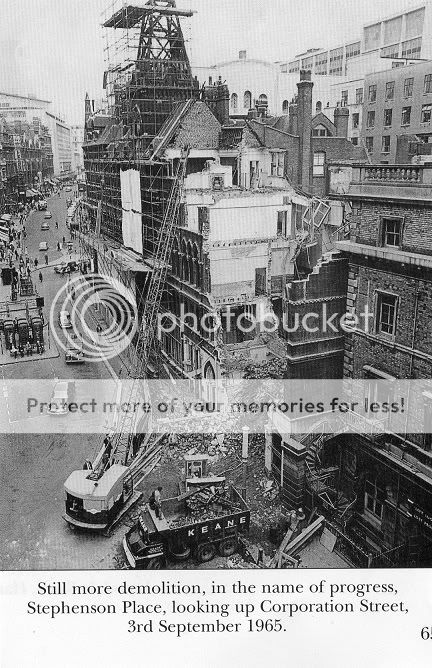BordesleyExile
master brummie
Exchange Stephenson Place
Showell wrote:
Exchange.—Corner of Stephenson Place and New Street, having a frontage of 64 feet to the latter, and 186 feet to the former. The foundation stone was laid January 2, 1863, the architect being Mr. Edward Holmes, and the building was opened January 2, 1865, the original cost being a little under £20,000. It has since been enlarged (1876-78) to nearly twice the original size, under the direction of Mr. J.A. Chatwin. The property and speculation of a private company, it was (December 2, 1880) incorporated, under the Joint Stock Companies' Act, and returns a fair dividend on the capital expended. In addition to the Exchange and Chamber of Commerce proper, with the usual secretarial and committee rooms appertaining thereto, refreshment, billiard, and retiring rooms, &c., there is a large assembly-room, frequently used for balls, concerts, and entertainments of a public character. The dimensions of the principal hall are 70 feet length, 40 feet width, with a height of 23 feet, the assembly-room above being same size, but loftier. The central tower is 110 feet high, the turret, in which there was placed a clock made by John Inshaw, to be moved by electro-magnetic power (but which is now only noted for its incorrectness), rising some 45 feet above the cornice. Other portions of the building are let off in offices.
https://ia331307.us.archive.org/2/items/showellsdictiona14472gut/14472-h/14472-h.htm
Such a pity that the Exchange was demolished in 1965
Showell wrote:
Exchange.—Corner of Stephenson Place and New Street, having a frontage of 64 feet to the latter, and 186 feet to the former. The foundation stone was laid January 2, 1863, the architect being Mr. Edward Holmes, and the building was opened January 2, 1865, the original cost being a little under £20,000. It has since been enlarged (1876-78) to nearly twice the original size, under the direction of Mr. J.A. Chatwin. The property and speculation of a private company, it was (December 2, 1880) incorporated, under the Joint Stock Companies' Act, and returns a fair dividend on the capital expended. In addition to the Exchange and Chamber of Commerce proper, with the usual secretarial and committee rooms appertaining thereto, refreshment, billiard, and retiring rooms, &c., there is a large assembly-room, frequently used for balls, concerts, and entertainments of a public character. The dimensions of the principal hall are 70 feet length, 40 feet width, with a height of 23 feet, the assembly-room above being same size, but loftier. The central tower is 110 feet high, the turret, in which there was placed a clock made by John Inshaw, to be moved by electro-magnetic power (but which is now only noted for its incorrectness), rising some 45 feet above the cornice. Other portions of the building are let off in offices.
https://ia331307.us.archive.org/2/items/showellsdictiona14472gut/14472-h/14472-h.htm
Such a pity that the Exchange was demolished in 1965










